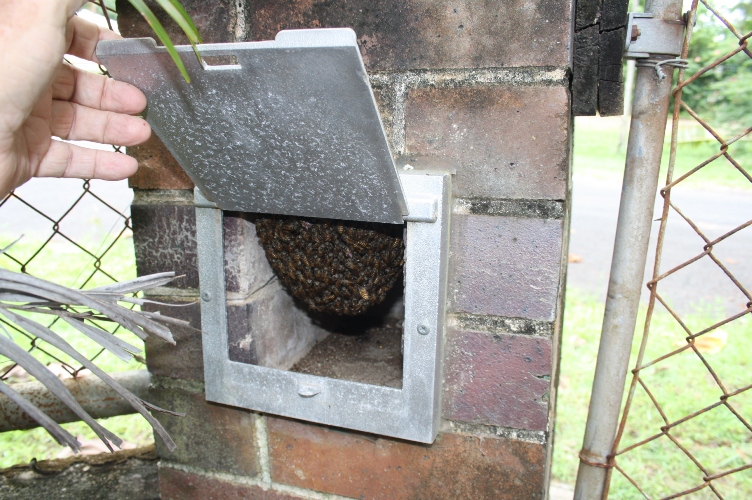The European beewolf (Philanthus triangulum) hunts
worker honey bees (Apis mellifera)
almost exclusively as a food source for offspring (Strohm et al, 2008). The
female beewolf paralyses the worker bee and stores several of them in an
underground nest chamber up to 1m long (Strohm et al, 2008). The beewolf then
closes up the nest entrance and creates a side entrance where she enters and creates
a chamber for brood where she will store 1-6 of the paralysed bees – on one she
will deposit an egg (Strohm et al, 2008). The female beewolf even licks the
bees, depositing a secretion from the postpharyngeal glands that prevents
fungal growth on the bee before the egg can hatch, ensuring there are
provisions for her young (Herzner et al, 2007). The beewolf then closes up the
brood chamber carefully and never has any contact with her offspring, but she
makes sure to leave the kids a packed lunch (Strohm et al, 2008).
European beewolf (Philanthus triangulum) and paralysed worker honey bee (Apis mellifera)
|
The female beewolf leaves little
opportunity for her vulnerable young to be predated on as she waits until after
she has collected food before depositing an egg, then immediately closes the
chamber (Strohm et al, 2008). The biggest threat to the beewolf is brood parasitism,
and it is believed the beewolf has adopted behaviours to avoid hunting when the
parasite species is most active known as an ‘enemy-free space strategy’ (Polidori
et al, 2010).
| cuckoo wasp (Hedychrum rutilans) approaches beewolf (Philanthus triangulum) nest |
There is a specialised cuckoo
wasp (Hedychrum rutilans) that has adapted
to parasitise the beewolf by depositing an egg in with the beewolf offspring
and provisions, that egg hatches and the larvae eats both the paralysed bees
and the beewolf offspring. It is believed the cuckoo wasp adopts a combination
of strategies to prevent being detected by the beewolf. The cuckoo wasp remains
motionless or runs away when they run into the beewolf in her nest and the
cuckoo wasp doesn’t leave much evidence of their deception (Strohm et al,
2008). The most interesting strategy though is that the cuckoo wasp avoids
detection when they are confronted by a beewolf inside her nest by producing
scents very similar to that of the beewolf and leaves inconspicuous scent marks
when they deposit an egg into the paralysed bee – this is believed to be the
first known chemical mimicry in a parasite of a solitary wasp (Strohm et al,
2008).
Below is a video showing an
interaction between the small parasitic cuckoo wasp and the much larger
beewolf.
References:
Strohm,E, Kroiss, J, Herzner,G, Laurien-Kehnen, C, Boland,
W, Schreier, P & Schmitt, T 2008, ‘A
cuckoo in wolves' clothing? chemical mimicry in a specialized cuckoo wasp of
the European beewolf (Hymenoptera, Chrysididae and Crabronidae)’, Frontiers
in Zoology, vol. 5.
Herzner, G, Schmitt, T, Peschke, K, Hilpert, A & Strohm, E 2007, ‘Food
wrapping with the postpharyngeal gland secretion by females of the European
beewolf Philanthus triangulum’, Journal of Chemical Ecology, vol.
33, pp. 849–859.
Polidori, C, Bevacqua, S & Andrietti, F 2010, ‘Do digger
wasps time their provisioning activity to avoid cuckoo wasps (Hymenoptera:
Crabronidae and Chrysididae)?’, Acta
Ethol, vol. 13, pp. 11-21.
Image 1: Schmidt, Y 2005, Sphecidae of Europe - Hymenoptera
Information System, viewed 28 May 2015, <http://uae.hymis.eu/images001/337_Philanthus_triangulum_Juergen_Schmidt_600x400.jpg>
Image 2: Naturalis
Historia 2011, Naturalis Historia, viewed 28 May 2015,
<http://www.naturalis-historia.de/bilder/Hedychrum%20rutilans%20f10.JPG>
Video: Bee
Wolf Wasp v.s. Cuckoo Wasp - slow motion test Corel Video Studio x5 2012,
youtube, viewed 28 May 2015, <https://www.youtube.com/watch?v=M3ApIC9B5I4>


